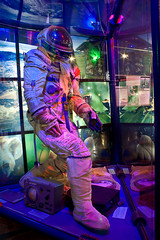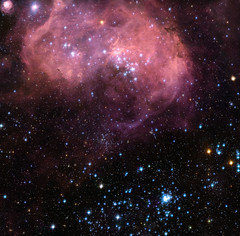
Аварийно-спасательный скафандр космонавта Артюхина
Originally uploaded by Julay Cat

A fisheye view of the Space Shuttle Discovery as it sits on Pad 39A for the final time, in preparation for its last mission STS-133.

33-2-55 ... NOT MY PHOTO. ... Image credit: NASA, ESA and Jesús Maíz Apellániz (Instituto de Astrofísica de Andalucía, Spain)
From www.spacetelescope.org/news/heic1011/?utm_source=feedburn...
Hubble captures bubbles and baby stars
A spectacular new NASA/ESA Hubble Space Telescope image — one of the largest ever released of a star-forming region — highlights N11, part of a complex network of gas clouds and star clusters within our neighbouring galaxy, the Large Magellanic Cloud. This region of energetic star formation is one of the most active in the nearby Universe.
The Large Magellanic Cloud contains many bright bubbles of glowing gas. One of the largest and most spectacular has the name LHA 120-N 11, from its listing in a catalogue compiled by the American astronomer and astronaut Karl Henize in 1956, and is informally known as N11. Close up, the billowing pink clouds of glowing gas make N11 resemble a puffy swirl of fairground candy floss. From further away, its distinctive overall shape led some observers to nickname it the Bean Nebula. The dramatic and colourful features visible in the nebula are the telltale signs of star formation. N11 is a well-studied region that extends over 1000 light-years. It is the second largest star-forming region within the Large Magellanic Cloud and has produced some of the most massive stars known.
It is the process of star formation that gives N11 its distinctive look. Three successive generations of stars, each of which formed further away from the centre of the nebula than the last, have created shells of gas and dust. These shells were blown away from the newborn stars in the turmoil of their energetic birth and early life, creating the ring shapes so prominent in this image.
Beans are not the only terrestrial shapes to be found in this spectacular high resolution image from the NASA/ESA Hubble Space Telescope. In the upper left is the red bloom of nebula LHA 120-N 11A. Its rose-like petals of gas and dust are illuminated from within, thanks to the radiation from the massive hot stars at its centre. N11A is relatively compact and dense and is the site of the most recent burst of star development in the region.
Other star clusters abound in N11, including NGC 1761 at the bottom of the image, which is a group of massive hot young stars busily pouring intense ultraviolet radiation out into space. Although it is much smaller than our own galaxy, the Large Magellanic Cloud is a very vigorous region of star formation. Studying these stellar nurseries helps astronomers understand a lot more about how stars are born and their ultimate development and lifespan.
Both the Large Magellanic Cloud and its small companion, the Small Magellanic Cloud, are easily seen with the unaided eye and have always been familiar to people living in the southern hemisphere. The credit for bringing these galaxies to the attention of Europeans is usually given to Portuguese explorer Fernando de Magellan and his crew, who viewed it on their 1519 sea voyage. However, the Persian astronomer Abd Al-Rahman Al Sufi and the Italian explorer Amerigo Vespucci recorded the Large Magellanic Cloud in 964 and 1503 respectively.
The Hubble Space Telescope is a project of international cooperation between ESA and NASA.

Manufacturer: Rockwell International Corporation
Country of Origin: United States of America
Dimensions:
Overall: 57 ft. tall x 122 ft. long x 78 ft. wing span, 150,000 lb. (1737.36 x 3718.57 x 2377.44cm, 68039.6kg)
Materials:
Aluminum airframe and body with some fiberglass features; payload bay doors are graphite epoxy composite; thermal tiles are simulated (polyurethane foam) except for test samples of actual tiles and thermal blankets.
The first Space Shuttle orbiter, "Enterprise," is a full-scale test vehicle used for flights in the atmosphere and tests on the ground; it is not equipped for spaceflight. Although the airframe and flight control elements are like those of the Shuttles flown in space, this vehicle has no propulsion system and only simulated thermal tiles because these features were not needed for atmospheric and ground tests. "Enterprise" was rolled out at Rockwell International's assembly facility in Palmdale, California, in 1976. In 1977, it entered service for a nine-month-long approach-and-landing test flight program. Thereafter it was used for vibration tests and fit checks at NASA centers, and it also appeared in the 1983 Paris Air Show and the 1984 World's Fair in New Orleans. In 1985, NASA transferred "Enterprise" to the Smithsonian Institution's National Air and Space Museum.

A front starboard view of the Entreprise. This thing is incredibly huge. You feel really small standing next to it.

Note the distinct fire from the solid booster rockets (solid plume of fire, very bright) and the shuttle's own main engines (smaller streaks just behind the tail)

The Rocket Garden at Kennedy Space Center in Florida looks majestic at night. Unfortunately, though, the light on the rockets produced an odd color cast and I didn't quite know what to do with it. I ended up with this.

Just few minutes before launch from Banana Creek Launch Viewing Site

ICESat lifted off on January 13, 2003, from Vandenberg Air Force Base, Calif., at 4:45 p.m. PST aboard Boeing’s Delta II rocket. Separation of the ICESat spacecraft occurred 64 minutes after launch at 5:49 p.m. PST. Initial contact with ICESat was made 75 minutes after launch at 6 p.m. PST as the spacecraft passed over the Svalbard Ground Station in Norway

Hello, this is the blind astrometry solver. Your results are:
(RA, Dec) center:(337.548016307, -18.3736705736) degrees
(RA, Dec) center (H:M:S, D:M:S):(22:30:11.524, -18:22:25.214)
Orientation:-174.09 deg E of N
Pixel scale:192.68 arcsec/pixel
Parity:Reverse ("Left-handed")
Field size :41.48 x 54.81 degrees
Your field contains:
The star Fomalhaut (αPsA)
The star Deneb Algedi (δCap)
The star Sadalsuud (βAqr)
The star Sadalmelik (αAqr)
The star γGru
The star Skat (δAqr)
The star Biham (θPeg)
The star Nashira (γCap)
The star 88Aqr
The star γPsc